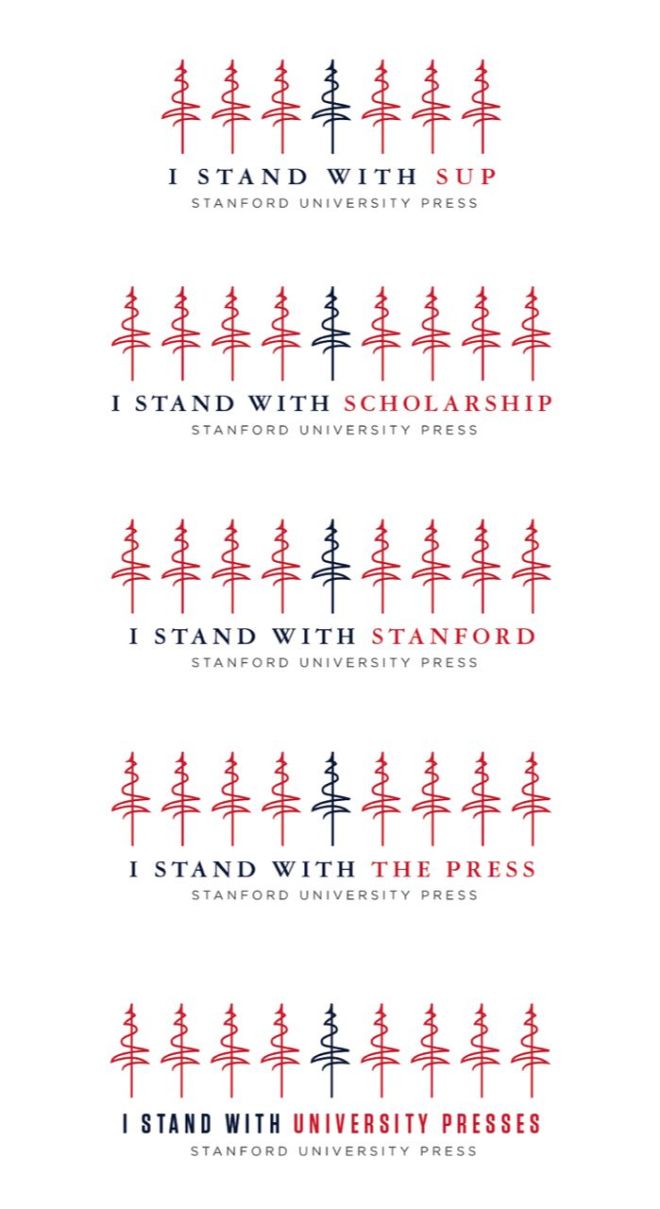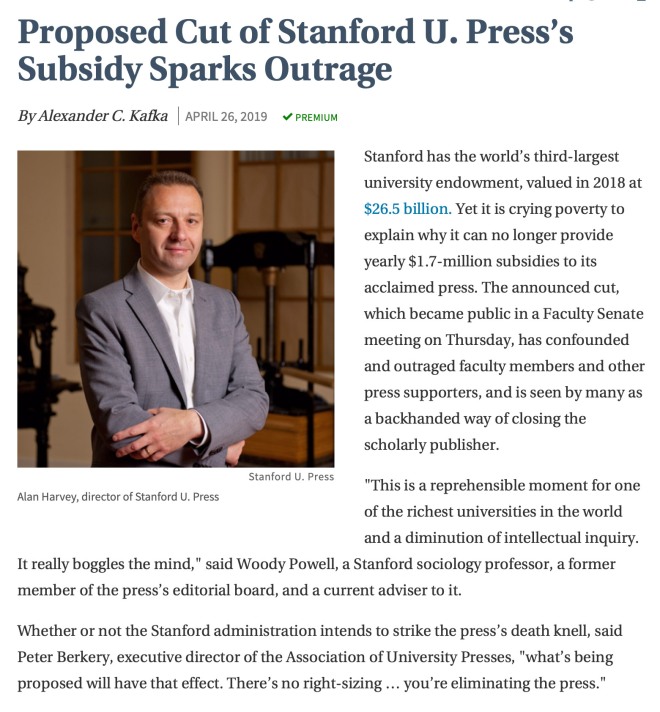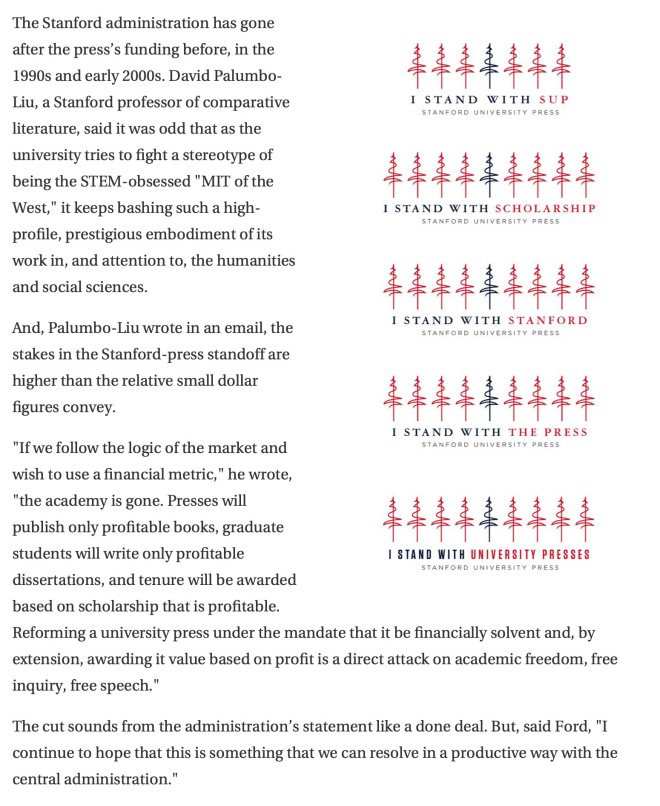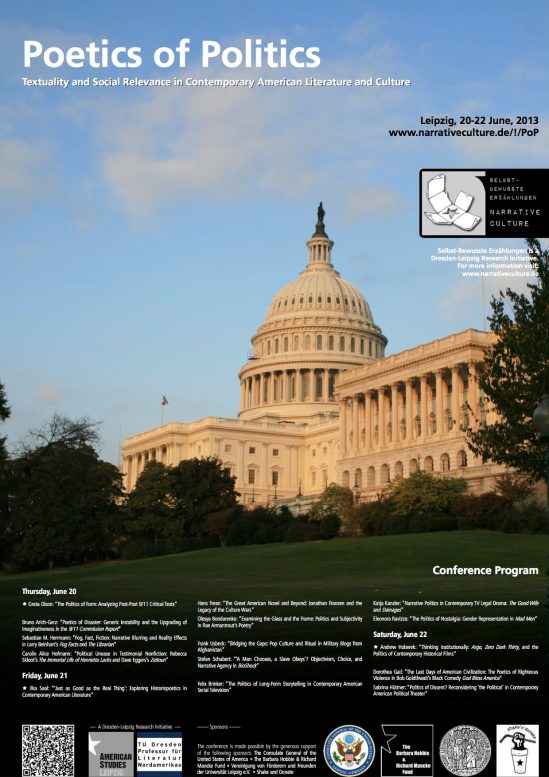
Excerpted from the Chronicle of Higher Education:

Another excerpt:

For more info, consider following my colleague David Palumbo-Liu on Twitter @palumboliu.

Excerpted from the Chronicle of Higher Education:

Another excerpt:

For more info, consider following my colleague David Palumbo-Liu on Twitter @palumboliu.


On Friday, June 21, 2013, Felix Brinker will be speaking about “The Politics of Long-Form Storytelling in Contemporary American Serial Television” at the “Poetics of Politics” conference in Leipzig. Felix’s talk builds upon recent work he’s been doing in the context of his dissertation project and related talks (for example, at the recent “It’s Not Television” conference in Frankfurt). Here is a preview of the upcoming talk:
The Politics of Long-Form Storytelling in Contemporary American Serial Television: On Popular Seriality, Operational Aesthetics, and Audience Productivity
Felix Brinker
The turn of American prime-time television dramas towards increasingly serialized storytelling during the last two decades seems to have coincided with an explicit politicization of their content. Especially shows discussed under the label of ‘Quality TV’ have been repeatedly celebrated and/or dismissed for their openly political agenda – be it for their engagement with the anxieties connected to the ‘War on Terror’ and the nebulous practices of intelligence agencies (as on Rubicon, Homeland and 24), or for attempts to tackle the social ills of contemporary urban America (as on The Wire or Breaking Bad). At the same time, other popular programs that at first glance seem to background political concerns in favor of more ‘escapist’ content (e.g. mystery-centric science-fiction or fantasy shows like Battlestar Galactica, Fringe, or Heroes) increasingly engage with matters of power, politics, and political intrigue and develop these motifs in ongoing storylines. While recent cultural and media studies publications on these phenomena have easily connected this renewed interest in political subject matters to the emergence of what Jason Mittell has termed ‘narratively complex television’ – that is, a (by now pervasive) shift in emphasis away from episodically contained storylines towards an ongoing serial narration that allows contemporary programming to construct richly furnished, expansive storyworlds and thus (among other things) opens up new possibilities for representing the complexities and intricacies of political systems and processes – less attention has so far been paid to the political dimensions of the increasingly active audience practices invited by such programming, and to the social aspects of popular seriality itself.
Located firmly within the competitive media environment of the convergence era, complex television series seek to engage their audiences in practices that extend well beyond ‘passive’ reception, and encourage them to become culturally and textually productive by participating in the discussion, interpretation and analysis of their favorite programs in dedicated online forums. Therefore, my paper argues that the political significance of narratively complex serial television manifests itself less on the level of content than on the level of form: By inviting their viewers to parse the complicated unfoldings of narratives across longer periods of time, as well as across different media formats and paratexts, contemporary prime-time dramas ask their audiences to dedicate a considerable amount of their time to the engagement with a serially expanding text. By doing so, narratively complex serials not only ask their viewers to engage in cognitively challenging and time-consuming reception practices, but also inspire them to engage in the laborious creation of unofficial paratexts (such as wikis, blogs, and fansites) which chart the developments of storylines and characters – paratexts that serve both to render the increasingly complicated narratives accessible and as ‘free’ promotional materials that ensure the cultural visibility of these programs. These shows therefore thrive on the ‘free’ (i.e. unpaid) work of their viewers and employ it to secure their own continued serial proliferation. Drawing on recent conceptualizations of popular seriality that understand the active participation of audiences as an activity that is integral to the economic viability serial storytelling in general, as well as on post-operaist takes on immaterial labor as the predominant form of work in post-industrial societies, my paper argues that the contemporary centrality of such ‘participatory’ practices marks a profound shift in the relationship between work and leisure (or between recreational activity and professional media use) that coincides with the digitalization of our media environment.
To make its argument, my paper will take a closer look at contemporary serial dramas like Homeland, The Wire, and House of Cards, and identify the textual strategies by which these shows encourage a particularly active audience behavior. Drawing on Neil Harris’s concept of the ‘operational aesthetic’, I argue that especially moments of formal/medial and thematic self-reflexivity – that is, moments in which these series thematize, demonstrate, and comment both on the operations of the serial text and on the logics of the diegetic events it narrates – constitute central fulcra for facilitating the audiences’ ongoing and sustained engagement with serial television narratives. By repeatedly producing such moments of non-alienating self-reflexivity – for example in scenes in which a show asks their viewers to ‘recall’ events from earlier episodes and visualizes this by having its characters use diegetic media technologies – complex television dramas manage to call attention to the logics of their own narrative operations and suggest a particular, preferred way of engaging with the text without detracting from the story that is being being told. At the same time, I argue, these moments become productive for the representations of political systems and processes, since they usually also serve to thematize diegetic logics, processes, and chains of cause and effect. Such instances of formal and thematic self-reflexivity thus constitute moments in which the serial logics of narratively complex televisions shows are on display, and from which one could trace out the relationships between their representational politics and the politics of popular serial formats themselves.
Watching election night coverage last night, I was struck by how commonplace a variety of presentation, visualization, and interfacing technologies have become in comparison to the last election four years ago, when many of these things were introduced and foregrounded — often somewhat awkwardly, as the videos here demonstrate. The shift has a great deal to do with much broader processes of habitualization through which touchscreen devices such as smartphones and tablet computers have been domesticated, de-exoticized, and rendered unspectacular in the intervening years. Taken for granted now as so much furniture of the lifeworld, it’s easy to lose sight of how fast these processes transpire, and of how differently things looked just a few years ago. In the interest, then, of cultivating a sort of media-archaeological awareness of the inherent transitionality and instability of our experiential and affective relations to the media-technical infrastructure of our lives, I’m posting here some glimpses from another world — several relevant video clips from the last presidential election night, along with some observations I originally posted the day after, on November 5, 2008:
America’s biggest media events, the Superbowl and the presidential election, are not simply mediated events but, centrally, events of mediation: showcases for new media technologies. This is a wonderful example. If I didn’t have a dissertation to write [update 2012: glad I’m done with that!], I’d be writing an article about CNN’s Virtual View (which is self-consciously placed “in the tradition of Princess Leia”). Watch them navigate between an ostensible story and a heightened awareness of the state-of-the-art special-effects. This is sci-fi, and not just because the “hologram” looks like something from Star Wars or because it seems to “beam” the correspondent in the style of Star Trek. This is sci-fi in a richer sense, because it perfectly utilizes the sci-fi film’s basic self-reflexive appeal to the technologies used to mediate its highly conventionalized story about technology.
Of course, the appearance of CNN’s holograph is not an isolated phenomenon. It partakes of a larger science-fiction context. The report of astronauts voting is a good example. Not only is outer space the traditional setting, the astronaut an established character, and the spaceship a central iconographic element in sci-fi; more importantly, the report provokes the question, as I asked last evening, how exactly did they cast their votes? With what kind of apparatus, via what channel of communication, and with what security measures in place? These are the same questions that one can ask about one’s local voting station: how do these new voting machines work, how do they communicate with one another, and are they trustworthy? The astronauts casting their votes are not interesting in themselves. Instead, they are an invitation to regard the apparently more mundane situation of earthbound voting from a technophilic, science-fiction perspective.
Meanwhile, the other networks foregrounded gigantic touchscreens, double ticker text lines, made-for-HDTV special features, and parallel online supplements in their bids to captivate viewers (see here for more). Since I couldn’t stay awake for it, I’ll be loading Obama’s victory speech (and maybe McCain’s concession of defeat while I’m at it) onto my iPod. Watching it there will in some way consummate the message of the medium, and I anticipate that it will also speak to a level at which consummation is eternally deferred: Now if I only had an iPhone or an iPod touch to match the tactile response, if not the scale, of those giant touchscreens [update 2012: the iPad had not been released yet…]. Isn’t that what this election was all about?
More required reading for anyone interested in popular culture, film, comics, media generally, Occupy, politics generally, the financial crisis, global capital, or life generally: David Graeber, anarchist anthropologist and author of Debt: The First 5000 Years, has a thought-provoking piece in The New Inquiry on superhero comics and their recent film incarnations (with special reference to Christopher Nolan’s Batman films). The piece starts provocatively enough:
Let me clarify one thing from the start: Christopher Nolan’s Batman: The Dark Knight Rises really is a piece of anti-Occupy propaganda.
From there, Graeber goes on to explore (perhaps not altogether unproblematically, but importantly) the politics of superhero comics from the mid twentieth century to the age of digital filmmaking and media convergence.
Dark Knight Rises offers an opportunity to ask some potentially enlightening questions about contemporary culture. What are superhero movies really all about? What could explain the sudden explosion of such movies—one so dramatic that it sometimes seems that comic book-based movies are replacing sci-fi as the main form of Hollywood special effects blockbuster, almost as rapidly as the cop movie replaced the Western as the dominant action genre in the ‘70s?
Why, in the process, have familiar superheroes suddenly been given complex interiority: family backgrounds, ambivalence, moral crises and self-doubt? And why does the very fact of their receiving a soul seem to force them to also choose some kind of explicit political orientation? One could argue that this happened first not with a comic-book character, but with James Bond. Casino Royale gave Bond psychological depth for the first time. By the very next movie he was saving indigenous communities in Bolivia from evil transnational water privatizers. Spiderman, too, broke left in his latest cinematic incarnation, just as Batman broke right.
This is an important piece, framed by consideration of Nolan’s latest Batman film, but really about the framing function of constituent power and the popular means for channeling, negotiating, and ultimately re-imagining it.
[scribd id=93517048 key=key-2d1la54ntx4iwuixjc3o mode=list]
For German-speaking readers of this blog…
As a post-doc at a German university, I support the above statement from the Verband der Historiker und Historikerinnen Deutschlands.
Check this out:
This book is intended to be a time capsule of the passions and emotions driving the movement. We are comic book & graphic novel artists and writers who’ve been inspired by the movement and hope to tell the stories of the people who are out there putting themselves at risk for an idea. What is that idea? Most of the media will tell you the idea is a vague and befuddled mess, but movements don’t coalesce around vague, befuddled messes. We hope that through the medium of comics we can share some of the ideas and experiences driving this movement.
Visit occupycomics.com for more info about the project, and go to their Kickstarter page if you’d like to support them.
[youtube http://www.youtube.com/watch?v=T_Jz408w3W0&w=560&h=315]
[youtube http://www.youtube.com/watch?v=WmJmmnMkuEM]
Above, video from UC Davis yesterday, in which heavily armed police officers brutally pepper-spray peaceful protestors at close range. Watch the whole video, though, for an incredible show of solidarity. The incident has prompted Assistant Professor Nathan Brown (Department of English, Program in Critical Theory at University of California at Davis) to post this open letter to Chancellor Linda P.B. Katehi, calling for her resignation.
The pain these officers inflicted will subside, but thanks to Youtube, the shame of their deeds is eternal. The world is watching.
See BoingBoing for more background and another video from an alternative POV.
[youtube http://www.youtube.com/watch?v=WkBnqHQ9Obs]
The more I think about it, #OccupyTheGoddamnBatman is a necessary development or outgrowth of #OWS. For one thing, there’s such an abundance of (coincidentally linked but thematically relevant) material that’s just asking to be appropriated (i.e. occupied) and virally reproduced, such as the photos from the film shoot that Keith Olbermann referenced. (A lot of this work has been started, as the images and clips here demonstrate.) As one commenter remarks on the pictures of the film shoot (there’s been talk of using protesters as extras):
“This weekend Batman visited New York and shot a home movie called The Dark Knight Rises with his buddy Christopher Nolan. The Occupy Wallstreet people may not have a job, a place to piss, or any hope for the future, but at least they got to meet the Goddamn Batman. And Catwoman was there, too. Rawr.”
Meanwhile, Frank Miller, author of the series that gave us the famous “goddamn Batman” line — and the meme it spawned — recently came out with some “putrid false righteousness” concerning the #Occupy movement (those are his words, which he uses to describe #OWS). See Miller’s post here, if you must, for his full condemnation of the protesters, whom he calls “pond scum” and “schmucks,” and about whom he writes insightful things like this:
“Occupy” is nothing short of a clumsy, poorly-expressed attempt at anarchy, to the extent that the “movement” – HAH! Some “movement”, except if the word “bowel” is attached – is anything more than an ugly fashion statement by a bunch of iPhone, iPad wielding spoiled brats who should stop getting in the way of working people and find jobs for themselves.
[youtube http://www.youtube.com/watch?v=zE-2ccp34fs]
In response to Miller’s blathering, digital illustrator Dane Cypel has begun the occupation of the goddamn Batman, recognizing that Miller’s “Batman’s not really the goddamn Batman, he’s also the goddamn one-percent”:
(“I’m the Goddamn 1%!”, from Cypel’s blog The Greatest Dane, here)
And here are some similarly themed images from around the Web:
#OccupyTheGoddamnBatman